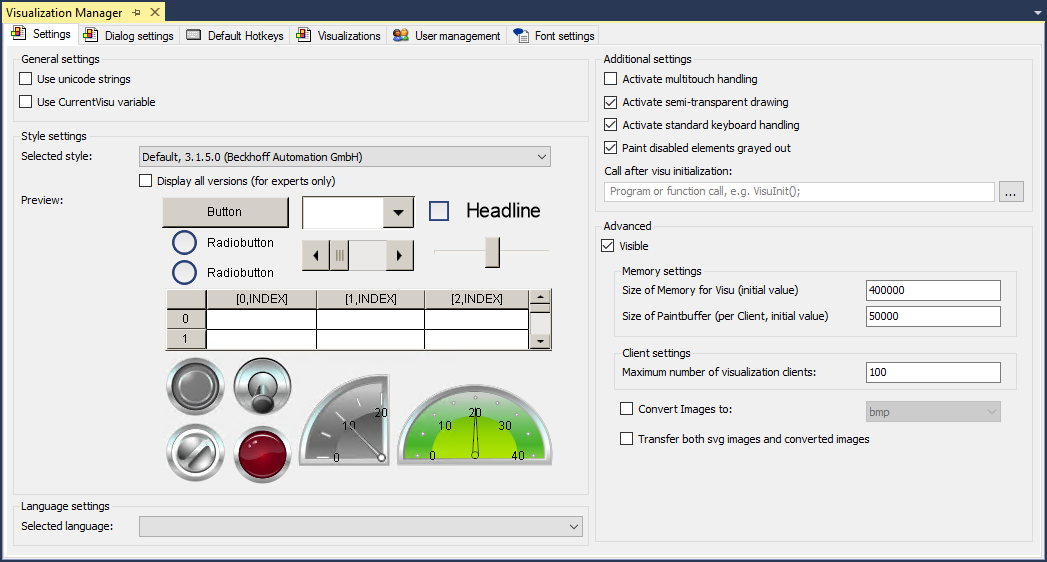Settings
The tab contains settings that apply to all visualizations of the PLC project.

General settings
Use Unicode strings | If this option is enabled, all strings that are used in the visualization are processed in Unicode format. To do this, "VISU_USEWSTRING" must be entered additionally under Compile > Settings > Compiler defines in the settings for the PLC project. |
Use CurrentVisu variable | The PLC project knows and uses the global variable VisuElems.CurrentVisu of type STRING. It contains the name of the currently active visualization at runtime. The variable can be accessed in read mode to obtain the name of the currently active visualization, and in write mode to change the visualization. The switchover takes place on all display devices in parallel so that the same visualization page is displayed on all connected clients. Requirement: The application contains a visualization that calls further visualizations. Samples:
|
Style settings
Selected style | Each visualization presents the elements in this style. |
Display all versions (for experts only) | If this setting is enabled, all style versions that are installed on the system are available for selection via the selection menu. |
Preview | The elements shown in the preview represent the selected style. |
Language settings
Selected language | The selected language is used when a visualization starts. |
 | A default language for the start of a visualization can only be set in conjunction with PLC HMI and/ or PLC HMI Web. With an integrated visualization, the text version ‘Standard’ is automatically used on startup. Language change at runtime via buttons on the visualization is also possible in the integrated visualization. |
See also:
 | From build 4024.0 the settings for the user management dialogs are listed on the separate Dialog settings tab and are documented there accordingly. |
Additional settings
Activate multitouch handling | At runtime the visualization expects user inputs via gestures and touch events. Affected elements:
|
Activate semi-transparent drawing | The visualization draws the elements in a semi-transparent color. Preset: Activated. Requirement: You create a new visualization, and the display variants can draw semi-transparently. |
Activate default keyboard operation |
|
Draw deactivated elements in gray | The visualization draws deactivated elements grayed out. |
Extended settings
Visible | Memory settings, file transfer mode and client settings are visible. (Not required for standard applications) |
 | If the integrated visualization is used, the unavailable settings are grayed out or not displayed at all. |
Memory settings
Size of Memory for Visu | Memory size in bytes, which the visualization allocates at runtime. Preset: 400000 |
Size of Paintbuffer (per Client) | Memory size in bytes, which the visualization allocates for each display option and uses for drawing actions. Preset: 50000 |
Client settings
Maximum number of Visualization Clients | Limits the number of display variants, which can run simultaneously. If you configure elements such that they vary depending on the display variant, you need to limit the number of display variants. A visualization is assigned an ID at runtime, which identifies the display variant. Data is then processed accordingly. TwinCAT can query the ID with the system variable CURRENTCLIENTID to obtain information on which of the current variants is affected. Sample: Requirement: Library VisuGlobalClientManager is integrated in the project. |
Convert images to | If this setting is enabled, you can select from a drop-down menu whether the images of the standard elements should be compiled in the bmp or png format. This is necessary if a Windows Embedded Compact operating system is installed on the target system, since only bmp, png and jpg images can be displayed there in the PLC HMI client. |
Transfer both svg images and converted images | If this setting is enabled, image files that had previously been converted to bmp or png can also be loaded to the target system in the original svg format. The PLC HMI client uses the image files in bmp or png format locally on the Beckhoff CE device and a PLC HMI Web client uses the image files in svg format. This setting is then available if both the PLC HMI and the PLC HMI Web are activated. |